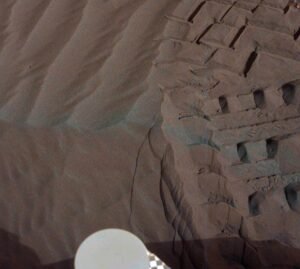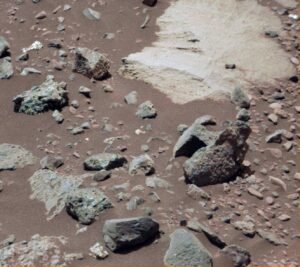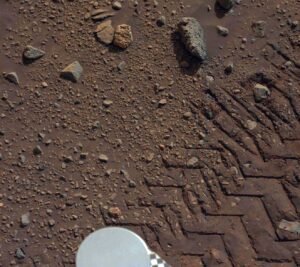Latest Posts
Curiosity Sol 2023, April 15, 2018
At 20:43:38 UTC, 16:18:06 local solar time, Mastcam Left captures its own freshly imprinted footprints on sand dunes named “Suilven Ripple”.Note the difference with the Sol 2017 image https://www.facebook.com/PianetaMarte.MdM/photos/a.1625578140858706.1073741828.1612043482212172/1668675009882352/ ), as well as the Sol 2020 image https://www.facebook.com/PianetaMarte.MdM/photos/a.1625578140858706.1073741828.1612043482212172/1673083946108125/ ).In this image, the footprints appear significantly deeper but less defined, while still showing some compactness. Especially in the upper right part of the image you can still notice some well-defined edges as well as the tendency to crumble into small fragmented layers, visible a bit lower; also in this case we are dealing with a wet though sandy soil?HD processed image: https://image.ibb.co/cO6kHS/Curiosity_Sol2023.jpg Original image: https://mars.jpl.nasa.gov/msl/multimedia/raw/?rawid=2023ML0106840000800234E01_DXXX&s=2023 This post has been automatically translated. See the original post here.
A young lava flow
This image shows an extremely young lava flow in Elysium Panitia. The almost complete absence of impact craters indicates an age probably less than a few million years, a trifle in geological terms. In addition, the exposed rock layers, visible in the full photo, are of particular interest as they provide additional information about the geologic history of Mars. This post has been automatically translated. See the original post here.
Curiosity Sol 2020, April 12, 2018
At 19:59:56 UTC, 17:30:43 local solar time, the Mastcam Left takes the traces impressed by a wheel of Curiosity itself on the Martian soil.This time, however, also appear on the ground “cracks” (enlarged in the box to the right of the image) that incredibly resemble the cracks that form when the clay is wet on the surface and then dried quickly at room temperature. Certainly such cracks could not form in absolutely dry soil consisting of sand as fine as talcum powder! HD processed image: https://image.ibb.co/eCwvWn/Curiosity_Sol2020.jpg Original image: https://mars.jpl.nasa.gov/msl/multimedia/raw/?rawid=2020ML0106590020800191E01_DXXX&s=2020 This post has been automatically translated. See the original post here.
SCIENCE VS DOGMATISM
We are all, well or badly, used to take for granted the distortion of information provided by the mass media.We all know very well how television and newspapers can sometimes distort reality according to the convenience of their respective editors.But according to some “fresconi” scientific information would be totally free from such mechanisms!These “fresconi” pretend to peddle pearls of wisdom in a dogmatic way, without “if” and without “but”. After a recent attack purely invective and without scientific arguments by experts who have believed in vain to put us in trouble, we decided to write this article to make a summary of the studies we have done that you can see individually as included in the article itself. We are aware of the intrinsic difficulty of the subject, and therefore we remain available to any type of clarification as long as addressed with respect and good manners. We wish everyone a good consultation. This post has been automatically translated. See the original post here.
Martian impact crater or supervolcano?
Images taken by Mars Express pose intriguing questions about the nature of the crater Ismenia Patera… This post has been automatically translated. See the original post here.
Mars Exploration Rovers Update: Opportunity continues into the Perseverance Valley and picks up the pace Sol 5013 – 5042
A beautiful account of the recent activities of the longest-lived rover on Mars! This post has been automatically translated. See the original post here.
The fungus that manages to survive on Mars
The experiment was performed on the Iss where scientists exposed a Cryomyces antarticus to the conditions of the Red Planet! Thanks to the report of a reader, I propose this article even though it is dated January 30, 2016.According to this research carried out on the International Space Station (ISS), not only bacteria but even molds and lichens would be able to proliferate on Mars even in the current conditions!I would say that putting together the numerous photos in which appear blue-greenish spots (many of which published recently on this page..) with this research, we should stop talking about Mars as a “dead rock”.Perhaps the question “Is there life on Mars?” should be replaced with “What lives on Mars?”. Obviously this article is a summary in Italian of a publication in English of which I propose you also the originals. Astrobiology Magzine:“ANTARCTIC FUNGI SURVIVE MARTIAN CONDITIONS ON THE INTERNATIONAL SPACE STATION”. https://www.astrobio.net/also-in-news/antarctic-fungi-survive-martian-conditions-on-the-international-space-station/ Complete research in PDF downloadable for free:“Survival of Antarctic Cryptoendolithic Fungi in Simulated Martian Conditions On Board the International Space Station”. https://www.researchgate.net/publication/296639131_Survival_of_Antarctic_Cryptoendolithic_Fungi_in_Simulated_Martian_Conditions_On_Board_the_International_Space_Station This post has been automatically translated. See the original post here.
Superfine tomatoes thanks to missions to Mars😋.
“The next time you eat a tomato or a bell pepper, look at it closely, because there’s a good chance its healthy appearance is due to former U.S. President Barack Obama’s speech and ESA’s research aimed at sending men into space for long-duration missions.” Being able to grow vegetables and greens in space may well make sense for astronauts, but why should we find certain “artificialities” in supermarkets instead of products that are certainly more natural grown in the fields and under a real sun?Maybe, but some “foxy” just do not understand!!! This post has been automatically translated. See the original post here.
Curiosity Sol 2016, April 8, 2018
At 11:20:45 UTC, 11:38:54 local solar time, the Mastcam Right shoots these very peculiar rocks on the Martian soil.The original image would appear to be a normal black and white image except for a “strange” screening. At a more careful analysis the strange dither was found to be a Bayer pattern (see https://it.wikipedia.org/wiki/Schema_Bayer), where the pixels are grouped in arrays 2X2 in which two pixels represent green and the other two red and blue.Established then that it was a Bayer mask, I could separate the three basic colors and then recompose a true RGB color image, of course at NASA come up with everything to complicate the lives of advertisers!In the end, however, it was worth it! The image obtained has been subjected to the usual white balance and here is the result!I find of extreme interest the strange shape of the rock located in the center-right of the frame, as well as the blue-greenish “incrustations” observed in several rocks in the image. RGB color processed image: https://image.ibb.co/msyTBc/Curiosity_Sol2016.jpg Original b/w image (Bayer scheme): https://mars.jpl.nasa.gov/msl/multimedia/raw/?rawid=2016MR0106340030902684C00_DXXX&s=2016 This post has been automatically translated. See the original post here.
Curiosity Sol 2017, April 9, 2018
At 15:55:10 UTC, 15:27:38 local solar time, Mastcam Left took this close-up image of the Martian soil.The original photo was subjected to white balance and a slight increase in color saturation and micro-contrast.At the top you can see a couple of porous-looking rocks “pockmarked” by greenish spots, similar to those observed in some photos of Opportunity but with a less intense coloration.But “the highlight” are the footprints left by the rover itself. The traces are impressed in an extraordinarily sharp way and in the areas where the wheel has exerted more pressure, the ground appears smooth and compact as if it were soft clay!In this area the ground looks much more like wet earth rather than just sand. HD processed image: https://image.ibb.co/csr1Ux/Curiosity_Sol2017.jpg Original image: https://mars.jpl.nasa.gov/msl/multimedia/raw/?rawid=2017ML0106410000800171E01_DXXX&s=2017 This post has been automatically translated. See the original post here.



